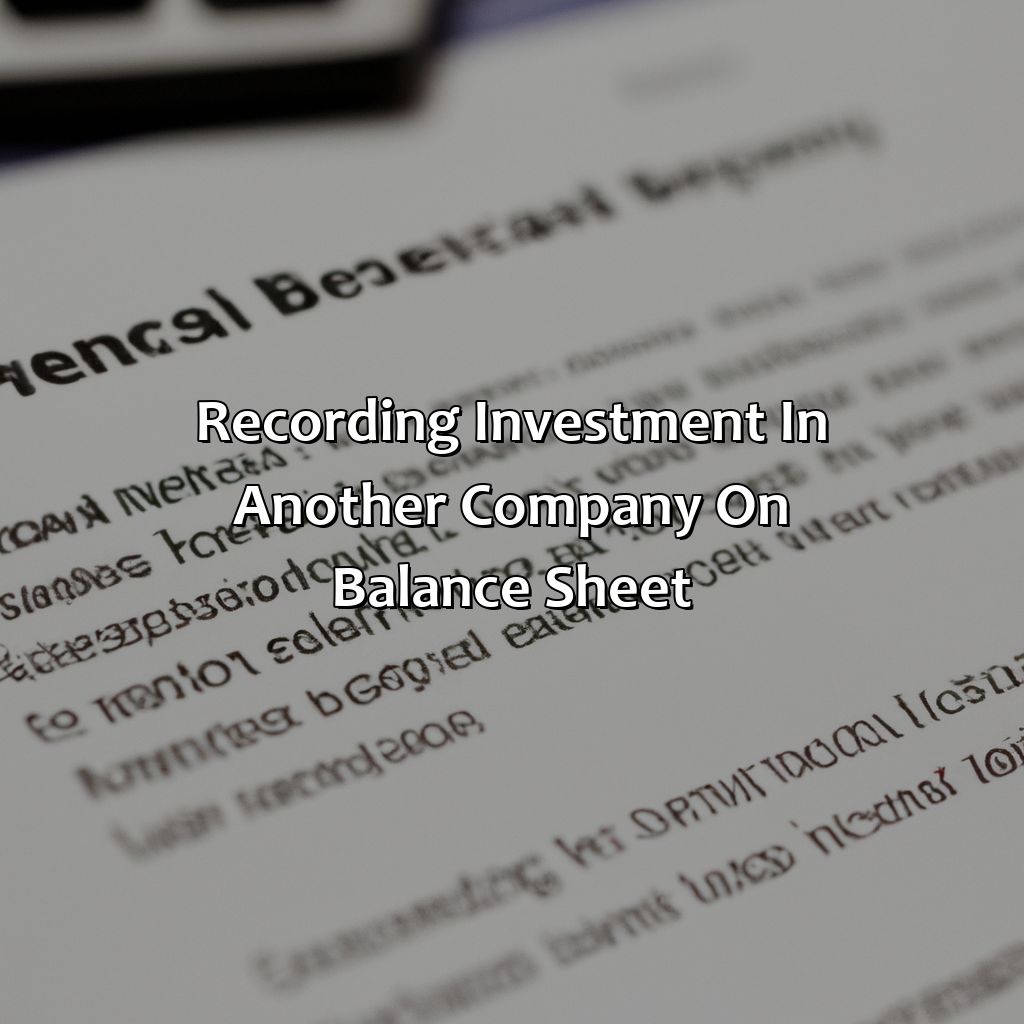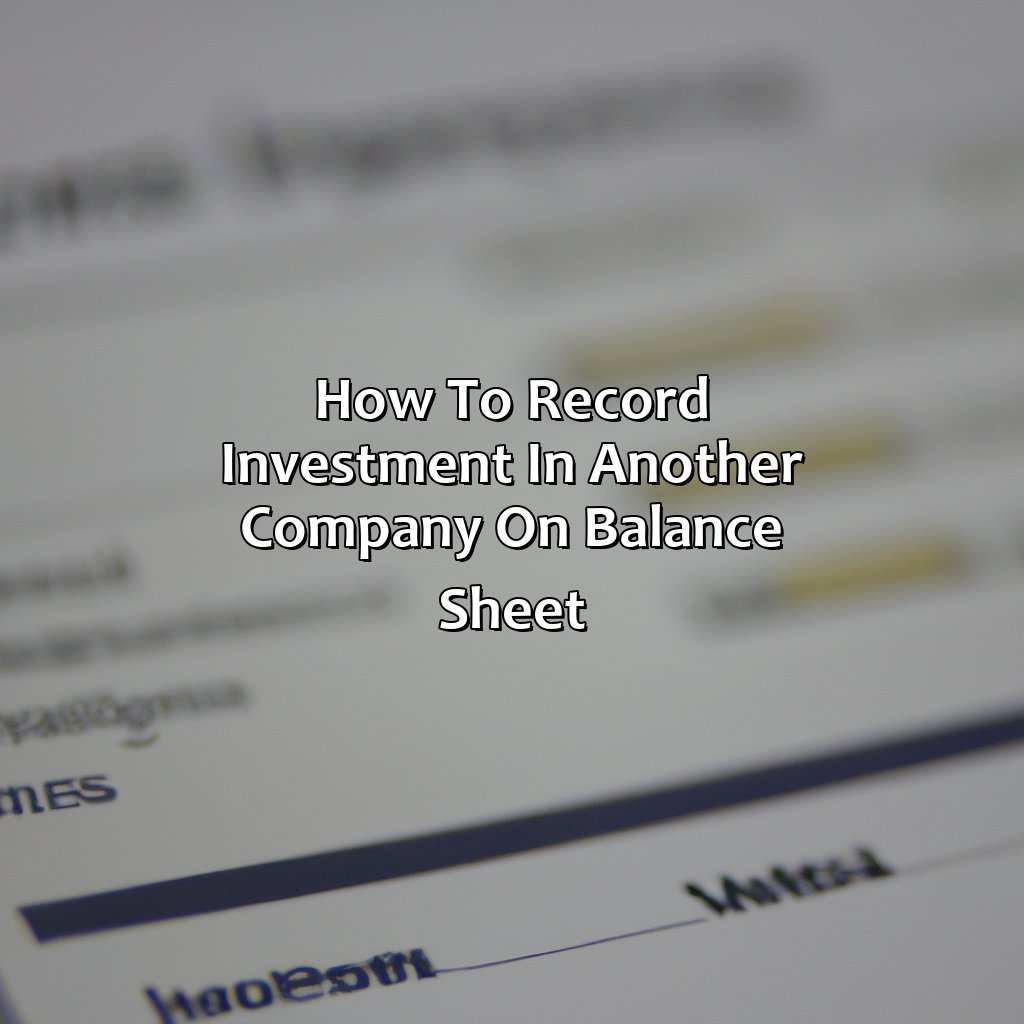How To Record Investment In Another Company On Balance Sheet?
Key Takeaway:
- Recording investment in another company on the balance sheet is important to accurately depict the financial position of the investing company. It can also impact the company’s financial ratios and stock price.
- The accounting standards for recording investment in another company depend on the type of investment and the level of control exercised by the investing company. Generally accepted accounting principles (GAAP) and international financial reporting standards (IFRS) provide guidelines for recording investments.
- The methods for recording investment in another company include the cost method, equity method, and consolidation method. The method chosen depends on the level of control and ownership of the investing company and the amount of influence it has over the invested company.
Are you looking to record investments in another company on your balance sheet? This article provides a comprehensive guide to help you navigate this crucial process. You’ll learn the different accounting procedures and standards required when recording investment transactions.
Recording Investment in Another Company on Balance Sheet
You need to understand the definition of investing in another company and the different types of investments to record it on your balance sheet. Accounting standards are important here. You have several methods to do this. We’ll explore each of these in more detail so you can easily sort this out.

Image credits: retiregenz.com by Yuval Washington
Definition of an Investment in Another Company
An investment in another company refers to holding a portion of ownership, be it stocks or shares, in an external enterprise. These investments are included on the balance sheet as assets and carried at their fair value. The profits earned from this investment can be either reinvested or distributed as dividends.
When recording an investment in another company on the balance sheet, it is essential to follow the Generally Accepted Accounting Principles (GAAP) guidelines and ensure that the information presented is accurate and reliable. Companies must accurately report any change in ownership percentage, dividends received, impairment losses, and gains or losses from selling any portion of the investment.
Furthermore, companies need to disclose any significant holdings they have in other companies within their financial statements. These disclosures will assist investors and stakeholders with making informed decisions about investing in the company itself based on its external commitments.
Investing in other companies can offer significant financial benefits; however, it’s crucial to note that there may also be associated risks. Therefore, businesses must evaluate these risks carefully before deciding to invest. By monitoring their investments’ performance regularly and reporting them accurately, companies can ensure they make sound financial decisions while minimizing risk exposure for themselves and stakeholders alike.
When it comes to investing in another company, it’s like dating – you need to know what type of relationship you’re getting into before you commit.
Types of Investments in Another Company
Investment Options in Another Company can be crucial for business growth. These options are available for companies of any size or nature. Here are some Investment Types to consider –
- Equity Securities – representing ownership interest
- Debt Securities – like bonds, notes etc.
- Convertibles – debt securities that can be converted to an equity security after a certain period
- Preferred Stocks – having higher dividends than owning common shares
- Mutual Funds or Exchange-Traded Funds (ETFs) – professionally managed investment portfolios
- Derivatives – available on currency, commodity or stock market playing the role of a movement predictor.
It’s important to know the risks and benefits of each option before investing. Companies should also research about Regulatory Requirements surrounding investments to meet legal obligations.
A well-known example dates back to 1987, when Berkshire Hathaway invested $700 million in Coca-Cola, becoming Coke’s largest shareholder. This decision added tremendously to the company’s wealth and transformed their portfolio structure.
Recording your investment in another company may seem daunting, but with the right accounting standards in place, it’s as easy as balancing a seesaw on a tightrope.
Accounting Standards for Recording Investment in Another Company
Recording an investment in another company on the balance sheet requires following specific accounting standards. These standards ensure accurate reporting and classification of the investment as either a short-term or long-term asset. The process involves recording the cost of the investment, any subsequent increases or decreases in its value, and any dividends received from the company.
Moreover, it is important to determine whether the investment is held-to-maturity, available-for-sale or trading securities while recording it on a balance sheet. The classification impacts how gains and losses are reflected in financial statements. Investments that are classified as available-for-sale or trading securities require fair value measurements for changes in their market prices. However, investments that are held-to-maturity can be recorded at amortized cost without reflecting changes in market prices.
According to AccountingTools.com, “The balance sheet should separately disclose details about each major category of investments owned by a company.” This ensures clarity about the nature of the investment accounting for any potential stakeholders reviewing financial statements.
It is worth noting that these accounting standards vary across jurisdictions and may change over time with amendments to accounting rules and regulations.
Recording your investment in another company is like adding a new member to your financial family tree- it’s important to do it right and keep track of all the branches.
Methods for Recording Investment in Another Company
Ascertaining Methods to Record Investment in Another Company
Companies make investments in other businesses as a strategic decision. There are various ways to record investment in another business on the balance sheet, which include:
| Method | Description |
| Cost Method | Investments are recorded at cost and adjusted for changes in value over time. |
| Equity Method | The investment is recorded as equity and adjusted for the proportionate share of income or losses. |
| Consolidation Method | The investment is consolidated into the parent company’s financial statements. |
One needs to understand that companies opt for different methods depending on their objective and compliance standards. It helps in keeping up with contemporary accounting standards.
It’s always advisable to consider the intricacies of each method before investing, considering short-term capital growth or long-term commitment, as it can impact the organization’s financial statements dramatically.
Make sure you choose an appropriate method depending upon your business strategy and goals. Choosing any approach hastily without comprehending your company’s financials could end up being perilous later.
Five Facts About How To Record Investment In Another Company On Balance Sheet:
An investment in another company on a balance sheet is typically recorded as a non-current asset. (Source: AccountingTools)
The value of the investment should be periodically reviewed and adjusted for impairment when necessary. (Source: Investopedia)
The accounting method used to record the investment depends on the level of control the investor has over the investee. (Source: Corporate Finance Institute)
The fair value of the investment can be used to determine the initial cost of the investment. (Source: Financial Accounting Standards Board)
Dividends received from the investee are typically recorded as income on the investor’s income statement. (Source: AccountingTools)
FAQs about How To Record Investment In Another Company On Balance Sheet?
How do I record an investment in another company on my balance sheet?
To record an investment in another company on your balance sheet, you would need to follow the guidelines provided by your accounting policies. In general, you would need to record the investment at cost as an asset under the long-term investments section of the balance sheet.
What does it mean to record an investment in another company on the balance sheet?
Recording an investment in another company on your balance sheet means that you are recognizing the value of your investment as an asset on your financial statement. This investment reflects the value of your ownership interest in the other company.
What information do I need to record an investment on my balance sheet?
To accurately record an investment on your balance sheet, you would need to have information such as the name of the company, the amount invested, the date of acquisition, and any other relevant information provided by your accounting policies.
What are the different methods of accounting for investments in another company on the balance sheet?
There are two main methods of accounting for investments in another company on the balance sheet: the equity method and the cost method. The equity method involves reporting the investor’s share of the earnings and assets of the investee company. The cost method involves reporting the investor’s investment in the investee company at cost.
What are the implications of recording an investment on the balance sheet?
Recording an investment on the balance sheet can affect several aspects of a company’s financial statements. For example, the investment can increase the value of the company’s assets or decrease the company’s cash balance. The recording of the investment can also affect the calculations of financial ratios, such as return on assets.
What are the risks and benefits of investing in another company?
Investing in another company can provide several benefits, such as diversification, potential for yield, and access to new markets. However, it also comes with risks, such as loss of principal, market risk, and risks specific to the investee company. It’s important for investors to carefully evaluate these risks and benefits before making an investment decision.
 Checkout this IRS Loophole
Checkout this IRS Loophole 
